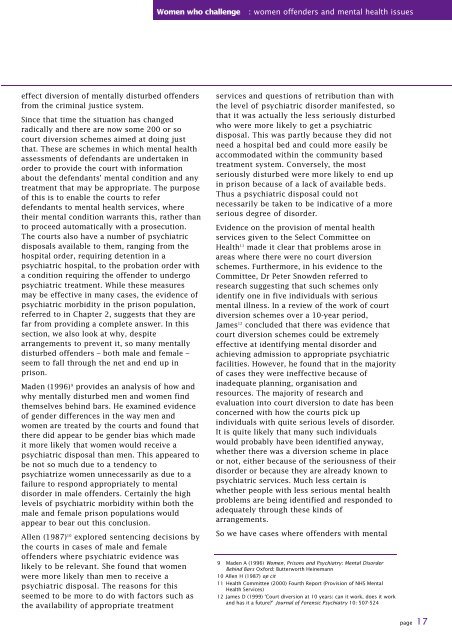Women who challenge - Nacro
Women who challenge - Nacro
Women who challenge - Nacro
- No tags were found...
You also want an ePaper? Increase the reach of your titles
YUMPU automatically turns print PDFs into web optimized ePapers that Google loves.
<strong>Women</strong> <strong>who</strong> <strong>challenge</strong>: women offenders and mental health issueseffect diversion of mentally disturbed offendersfrom the criminal justice system.Since that time the situation has changedradically and there are now some 200 or socourt diversion schemes aimed at doing justthat. These are schemes in which mental healthassessments of defendants are undertaken inorder to provide the court with informationabout the defendants’ mental condition and anytreatment that may be appropriate. The purposeof this is to enable the courts to referdefendants to mental health services, wheretheir mental condition warrants this, rather thanto proceed automatically with a prosecution.The courts also have a number of psychiatricdisposals available to them, ranging from thehospital order, requiring detention in apsychiatric hospital, to the probation order witha condition requiring the offender to undergopsychiatric treatment. While these measuresmay be effective in many cases, the evidence ofpsychiatric morbidity in the prison population,referred to in Chapter 2, suggests that they arefar from providing a complete answer. In thissection, we also look at why, despitearrangements to prevent it, so many mentallydisturbed offenders – both male and female –seem to fall through the net and end up inprison.Maden (1996) 9 provides an analysis of how andwhy mentally disturbed men and women findthemselves behind bars. He examined evidenceof gender differences in the way men andwomen are treated by the courts and found thatthere did appear to be gender bias which madeit more likely that women would receive apsychiatric disposal than men. This appeared tobe not so much due to a tendency topsychiatrize women unnecessarily as due to afailure to respond appropriately to mentaldisorder in male offenders. Certainly the highlevels of psychiatric morbidity within both themale and female prison populations wouldappear to bear out this conclusion.Allen (1987) 1 0 e x p l o red sentencing decisions bythe courts in cases of male and femaleo ffenders where psychiatric evidence waslikely to be relevant. She found that womenw e re more likely than men to receive apsychiatric disposal. The reasons for thisseemed to be more to do with factors such asthe availability of appropriate tre a t m e n ts e rvices and questions of retribution than withthe level of psychiatric disorder manifested, sothat it was actually the less seriously disturbed<strong>who</strong> were more likely to get a psychiatricdisposal. This was partly because they did notneed a hospital bed and could more easily beaccommodated within the community basedt reatment system. Conversely, the mostseriously disturbed were more likely to end upin prison because of a lack of available beds.Thus a psychiatric disposal could notnecessarily be taken to be indicative of a moreserious degree of disord e r.Evidence on the provision of mental healthservices given to the Select Committee onHealth 11 made it clear that problems arose inareas where there were no court diversionschemes. Furthermore, in his evidence to theCommittee, Dr Peter Snowden referred toresearch suggesting that such schemes onlyidentify one in five individuals with seriousmental illness. In a review of the work of courtdiversion schemes over a 10-year period,James 12 concluded that there was evidence thatcourt diversion schemes could be extremelyeffective at identifying mental disorder andachieving admission to appropriate psychiatricfacilities. However, he found that in the majorityof cases they were ineffective because ofinadequate planning, organisation andresources. The majority of research andevaluation into court diversion to date has beenconcerned with how the courts pick upindividuals with quite serious levels of disorder.It is quite likely that many such individualswould probably have been identified anyway,whether there was a diversion scheme in placeor not, either because of the seriousness of theirdisorder or because they are already known topsychiatric services. Much less certain iswhether people with less serious mental healthproblems are being identified and responded toadequately through these kinds ofarrangements.So we have cases where offenders with mental9 Maden A (1996) <strong>Women</strong>, Prisons and Psychiatry: Mental DisorderBehind Bars Oxford: Butterworth Heinemann10 Allen H (1987) op cit11 Health Committee (2000) Fourth Report (Provision of NHS MentalHealth Services)12 James D (1999) ‘Court diversion at 10 years: can it work, does it workand has it a future?’ Journal of Forensic Psychiatry 10: 507-524page 17
















